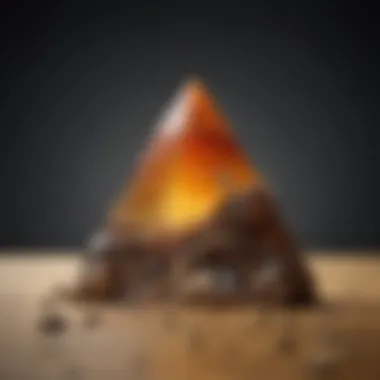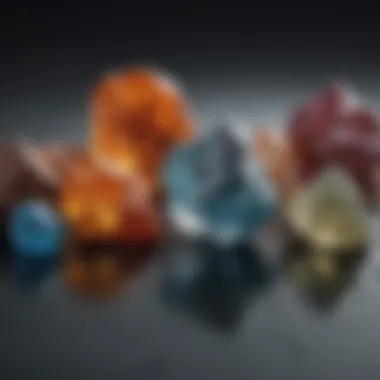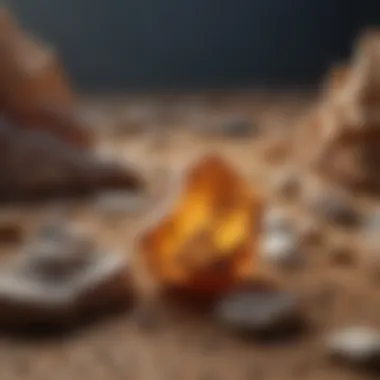Unveiling the Fascinating World of the Mohs Hardness Scale: An In-Depth Exploration


Rock and Fossil Identification
In the captivating realm of mineralogy, rock and fossil identification serve as the bedrock of understanding the Earth's geological treasures. When embarking on the quest to distinguish various rocks and fossils, individuals must familiarize themselves with the distinct types that populate the intricate tapestry of our planet. Whether igneous, sedimentary, or metamorphic rocks, each classification unveils unique characteristics waiting to be explored. Furthermore, fossil identification adds a riveting layer to this pursuit, shedding light on ancient life forms preserved in geological matter. To hone one's discerning eye, aspiring collectors should pay close attention to specific features such as texture, color, hardness, and any embedded minerals or imprints. The keen use of tools such as magnifying glasses, scratch tests, and ultraviolet lights can significantly aid in precise identification efforts.
Collecting Tips and Techniques
The art of collecting rocks and fossils transcends mere hobby; it is a profound communion with Earth's history and splendor. To maximize the collecting experience, enthusiasts are encouraged to adhere to a set of best practices that ensure not only the preservation of specimens but also the conservation of natural environments. By respecting guidelines such as obtaining permission for excavation, adhering to ethical collection limits, and documenting the locality and conditions of findings, collectors contribute to the sustainability of their endeavors. Moreover, scouting prime collecting sites promises thrilling discoveries, as regions rich in geological wonders beckon with their hidden treasures. However, the process of safely extracting specimens demands delicacy and precision to avoid damage and preserve the integrity of the specimen.
Preservation and Display
Preserving the timeless allure of rocks and fossils is a delicate art that requires meticulous care and foresight. Employing various preservation techniques such as cleaning, drying, and sealing specimens safeguards their longevity and integrity for generations to come. Proper storage methods, encompassing suitable containers, labels detailing origin and date of acquisition, and controlled environmental conditions, are pivotal in maintaining the pristine state of collected treasures. Creativity blooms in the realm of display, where rocks and fossils can be showcased in imaginative and aesthetically pleasing arrangements. From framed displays to thematic exhibits, the possibilities for honoring these geological marvels are as boundless as the Earth itself.
Geological Insights
Delving into the geological insights afforded by rocks and fossils opens a portal to Earth's profound history and evolution. Exploring the intricate formations and processes that have shaped our planet unravels a narrative of eons past, providing a glimpse into the forces that have sculpted the world we inhabit. Furthermore, the historical significance of certain rocks and fossils carries echoes of ancient worlds and extinct species, sparking a sense of wonder and awe in enthusiasts. Notable discoveries in the field continually enrich our understanding of Earth's geological tapestry, unveiling hidden gems and opening new chapters in the ongoing story of our planet's geological heritage.
Introduction to Mohs Hardness Scale
The Mohs Hardness Scale serves as a pivotal tool in the realm of mineralogy, offering invaluable insights into the hardness of various minerals. Its significance lies in providing a standardized method for determining the relative hardness of minerals, aiding in their identification and classification. This article delves into the intricacies of the Mohs Hardness Scale, shedding light on its origins, practical applications, and the hardness rankings of different minerals.
Understanding the Concept
Definition of Hardness in Minerals


Exploring the definition of hardness in minerals is crucial to grasp the foundation of the Mohs Hardness Scale. The concept of hardness in minerals refers to the ability of a mineral to withstand scratching or abrasion. Understanding this aspect is essential as it forms the basis for the ranking system established by Friedrich Mohs. This unique characteristic enables mineralogists and geologists to differentiate between various minerals based on their relative hardness, offering a fundamental tool for classification.
Historical Background of Mohs Scale
Delving into the historical background of the Mohs Scale provides valuable insights into its development and evolution over time. Originating in the early 19th century by Friedrich Mohs, this scale revolutionized the field of mineralogy by introducing a practical method for assessing mineral hardness. The simplicity and effectiveness of the scale led to its widespread adoption in the scientific community, making it a pivotal aspect of mineral classification and identification.
Significance in Mineralogy
Role in Mineral Identification
The Mohs Hardness Scale plays a crucial role in mineral identification, offering a quick and reliable method for distinguishing between different minerals. By assessing the hardness of a mineral using this scale, mineralogists can narrow down possible mineral identities, facilitating accurate classification. This aspect enhances the efficiency of mineralogical studies and aids in building comprehensive mineral collections.
Comparison to Other Hardness Scales
Comparing the Mohs Hardness Scale with other existing hardness scales provides a broader perspective on its utility and effectiveness. While other scales may offer different approaches to measuring hardness, the Mohs Scale stands out due to its simplicity and ease of use. The intuitive nature of the Mohs Scale makes it a popular choice among mineralogists and collectors, underscoring its significance in the field of mineralogy.
Practical Applications
Use in Geology and Gemology
The practical applications of the Mohs Hardness Scale extend beyond mineral identification, finding relevance in the fields of geology and gemology. Geologists utilize the scale to assess the hardness of rocks and minerals during fieldwork, aiding in geological mapping and mineral exploration. In gemology, the scale is instrumental in evaluating the durability of gemstones and guiding cutting and polishing processes, enhancing the quality and value of gemstone preparations.
Impact on Industrial Processes
The impact of the Mohs Hardness Scale on industrial processes is substantial, influencing various sectors such as construction, manufacturing, and mining. Understanding the hardness of minerals and rocks is crucial in determining their suitability for industrial applications. By utilizing the Mohs Scale, industries can select materials that align with their specific hardness requirements, optimizing processes and ensuring product quality.


Mohs Hardness Scale Chart
The Mohs Hardness Scale Chart holds a pivotal role in elucidating the complex nature of mineral hardness within the context of this in-depth exposition. By presenting a structured ranking system for minerals based on their relative hardness levels, the Mohs Hardness Scale Chart becomes a fundamental tool for mineralogists and enthusiasts alike. This chart not only aids in the identification and comparison of various minerals but also serves as a valuable reference point for understanding the durability and physical properties of different mineral specimens. Its significance lies in its ability to provide a standardized method for assessing the hardness of minerals, offering insights into their geological formations, industrial applications, and practical uses throughout multiple fields.
Mineral Hardness Rankings
- Talc: The inclusion of Talc in the Mineral Hardness Rankings section is essential for comprehensively deciphering the characteristics and properties of this mineral in relation to the broader topic of the Mohs Hardness Scale. Talc, known for its exceptional softness and greasy feel, holds a pivotal position in the ranking system due to its low hardness level of 1 on the Mohs Scale. While its softness may present challenges in certain applications, such as jewelry making, Talc's unique properties make it a preferred choice in industries like cosmetics and pharmaceuticals where its lubricating qualities are advantageous.
- Gypsum: Gypsum, a mineral renowned for its distinctively soft composition and varied crystalline forms, contributes significantly to the narrative surrounding mineral hardness within the Mohs Hardness Scale framework. With a hardness level of 2 on the scale, Gypsum offers a balance between pliability and stability, making it a versatile choice for applications ranging from construction materials to artistic developments. Its ease of manipulation and molding properties render Gypsum a popular selection within the mineral collections featured in this article.
- Calcite: Within the spectrum of mineral hardness rankings, Calcite emerges as a prominent feature due to its intermediate hardness level of 3 on the Mohs Scale. Recognized for its rhombohedral crystal structure and calcium carbonate composition, Calcite embodies a unique fusion of beauty and resilience, making it a sought-after inclusion in mineral collections. Despite its susceptibility to acid erosion, Calcite's remarkable clarity and varied colorations validate its enduring allure in both educational and aesthetic contexts.
- Fluorite: Positioned at number 4 on the Mohs Hardness Scale, Fluorite embodies a fascinating amalgamation of hardness and fluorescence, creating a captivating subject within the mineral hardness rankings discourse. Known for its exceptional color range and crystal formations, Fluorite's relative hardness makes it a durable and popular choice for jewelry, carvings, and ornamental pieces. Its distinctive optical properties and geological occurrences further underscore Fluorite's significance in both scientific and collector communities.
Implications for Collectors
In this extensive guide delving into the mysteries of the Mohs Hardness Scale, the section on Implications for Collectors holds paramount importance. For rock and fossil collectors, understanding the practical implications of this scale is crucial in determining the durability and suitability of specimens for their collections. By discerning the hardness of various minerals, collectors can make informed decisions on which specimens to acquire, display, or handle, thereby preserving the integrity and longevity of their collections.
Selecting Minerals for Collections
Durable vs. Fragile Specimens
Exploring the dynamic between durable and fragile specimens is essential in the realm of mineral collections. Durable specimens boast resilience against wear and damage, making them ideal for long-term display and handling. Their robust nature ensures that they can withstand the test of time, enabling collectors to showcase them without fear of degradation. In contrast, fragile specimens require delicate care and controlled environments to prevent breakage or deterioration. While fragile specimens may offer unparalleled beauty, collectors must weigh the risk of damage against the aesthetic value when including them in their collections.
Display Considerations
The aspect of display considerations plays a pivotal role in enhancing the visual allure and educational value of mineral collections. Proper display techniques not only showcase the uniqueness of each specimen but also protect them from environmental factors that could compromise their integrity. Factors such as lighting, humidity, and mounting methods all contribute to an effective display. Collectors must strike a balance between aesthetic presentation and conservation measures to ensure that their collections remain visually appealing while maintaining the specimens' pristine condition.
Preservation Techniques


Avoiding Hardness Discrepancies
An essential aspect of mineral collection preservation is avoiding hardness discrepancies. Mismatched hardness levels between specimens can lead to abrasion or scratching during storage or display. To mitigate this risk, collectors should categorize and store minerals with similar hardness levels together. By adhering to proper handling protocols and using protective measures such as padding or individual casings, collectors can prevent inadvertent damage due to hardness discrepancies.
Storage Guidelines
Effectively storing mineral specimens is crucial for their long-term preservation. Implementing suitable storage guidelines involves considerations such as temperature control, humidity regulation, and protection from light exposure. By storing minerals in acid-free containers, cabinets, or display cases with adjustable shelving, collectors can create an optimal environment that minimizes the risk of degradation. Regular monitoring and maintenance of storage conditions are essential to ensure the longevity and quality of mineral collections.
Enhancing Knowledge and Appreciation
In the realm of mineralogy, Enhancing Knowledge and Appreciation holds paramount importance as it delves into the intricate world of minerals, offering enthusiasts a deeper understanding and appreciation for the subject matter. This section aims to enlighten readers on the essential aspects that contribute to a comprehensive grasp of the Mohs hardness scale and its implications. By emphasizing the significance of continual learning and cultivating a passion for minerals, individuals can uncover the wonders hidden within the earth's depths.
Educational Outreach
Incorporating Mohs Scale in Teaching
Incorporating the Mohs Scale in Teaching is a pivotal method in providing learners with a hands-on opportunity to grasp the concept of mineral hardness. By integrating this fundamental scale into educational curricula, teachers can impart practical knowledge that bridges theoretical learning with real-world applications. The distinctive feature of Incorporating Mohs Scale in Teaching lies in its ability to transform abstract ideas into tangible experiences for students. This approach not only enhances comprehension but fosters a lasting connection with the subject matter, creating a more enriched learning environment within the context of mineralogy.
Hands-on Learning Activities
Hands-on Learning Activities play a crucial role in solidifying the concepts related to the Mohs hardness scale. By actively engaging participants in tactile exercises such as scratch tests and mineral identification, these activities provide a multi-sensory experience that reinforces understanding and retention. The key characteristic of Hands-on Learning Activities is their interactive nature, enabling participants to explore the hardness of various minerals firsthand. This hands-on approach not only enhances learning outcomes but also cultivates a sense of discovery and inquiry, making it a valuable and popular choice for immersing individuals in the complexities of mineral hardness.
Cultivating a Passion for Minerals
Inspiring Curiosity and Exploration
Inspiring Curiosity and Exploration serves as a driving force behind nurturing a passion for minerals among enthusiasts. By encouraging individuals to question, investigate, and marvel at the unique characteristics of minerals, this aspect sparks a sense of wonder and inquisitiveness. The key characteristic of Inspiring Curiosity and Exploration is its ability to ignite a sense of excitement and fascination, motivating individuals to delve deeper into the captivating world of mineralogy. This approach not only instills a love for learning but also fosters a lifelong curiosity that transcends mere academic interest.
Connecting with the Natural World
Connecting with the Natural World through the study of minerals offers enthusiasts a profound connection to the earth's geological history. By immersing oneself in the raw beauty and diversity of minerals, individuals can develop a deep appreciation for the natural wonders that surround them. The key characteristic of Connecting with the Natural World is its ability to evoke a sense of reverence and respect for the environment, underscoring the importance of conservation and preservation. By forging this intimate link with the natural world, individuals can gain a newfound perspective on their place in the larger tapestry of geological marvels, enriching their understanding and appreciation for the treasures that lie beneath the surface.







